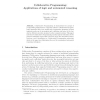Free Online Productivity Tools
i2Speak
i2Symbol
i2OCR
iTex2Img
iWeb2Print
iWeb2Shot
i2Type
iPdf2Split
iPdf2Merge
i2Bopomofo
i2Arabic
i2Style
i2Image
i2PDF
iLatex2Rtf
Sci2ools
CADE
2008
Springer
2008
Springer
Collaborative Programming: Applications of Logic and Automated Reasoning
Collaborative Programming is characterized by groups of people issuing instructions to computer systems. Collaborative Programming languages differ from traditional programming languages because instruction sets can be incomplete and conflicting, and more of the burden for efficient execution is placed on the computer system. This paper introduces Collaborative Programming and through the discussion of two practical examples argues that tools from logic and automated reasoning form a good foundation for Collaborative Programming technology while at the same time illustrating the need for nonstandard automated reasoning techniques.
Automated Reasoning | CADE 2008 | Collaborative Programming | Nonstandard Automated Reasoning | People Issuing Instructions |
| Added | 03 Dec 2009 |
| Updated | 03 Dec 2009 |
| Type | Conference |
| Year | 2008 |
| Where | CADE |
| Authors | Timothy L. Hinrichs |
Comments (0)

